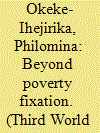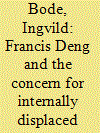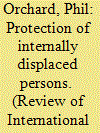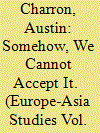|
|
|
Sort Order |
|
|
|
Items / Page
|
|
|
|
|
|
|
| Srl | Item |
| 1 |
ID:
174549


|
|
|
|
|
| Summary/Abstract |
This paper draws on fieldwork at three camps for internally displaced persons (IDPs) in Northeast Nigeria. It interrogates the pre-displacement experiences of participants, their transition to and experiences of internal displacement, vignettes of life at IDP camps, their relationship with host communities, the non-universality of experiences of sexual and gender-based violence among female IDPs (despite the particularities of experiences of women and young girls) and the resilience and agency of IDPs. The paper argues that scholarly engagement with IDPs and their social conditions should go beyond fixation on or fetishisation of poverty. Overall, the paper contributes to the empirical literature on conditions of internal displacement in sub-Saharan Africa.
|
|
|
|
|
|
|
|
|
|
|
|
|
|
|
|
| 2 |
ID:
130706


|
|
|
|
|
| Publication |
2014.
|
| Summary/Abstract |
Using the case of Francis Deng as representative of the Secretary-General for internally displaced persons as an example, this article considers how temporary civil servants may become intellectual leaders within the United Nations. During his 1992-2004 tenure, Deng managed to raise assistance and protection expectations for the internally displaced through framing their concerns in the concept of sovereignty as responsibility. He also contributed to legal change through formulating protection and assistance standards-the Guiding Principles on Internal Displacement. The article argues that a combination of three factors enabled him to exercise intellectual leadership. First, his insider-outsider position at the border between the UN Secretariat (the second UN) and the nongovernmental organizations, academic scholars, and independent experts who engage regularly with the UN (the third UN); second, his personal qualities; and third, his effective ways of framing at an opportune moment in time.
|
|
|
|
|
|
|
|
|
|
|
|
|
|
|
|
| 3 |
ID:
095610


|
|
|
|
|
| Publication |
2010.
|
| Summary/Abstract |
Internal displacement is increasingly perceived as an international problem. This has led to suggestions that international norms have begun to govern state behaviour towards their own displaced populations. I argue that this change occurred through the innovative use of soft law, in particular the guiding principles on internal displacement, by a consortia of norm entrepreneurs including NGOs and a UN Office, that of the Representative of the Secretary-General for Internally Displaced Persons. As soft law, these principles lack the usual markers which suggest an emerging norm. Instead, the article argues that alternative methods - including the international recognition of the principles and their adoption in domestic legislation - has triggered a change in state behaviour. This is demonstrated by examining two cases of forcible return of IDPs - the closure of the Kibeho Camp in Rwanda in 1995, before the principles were created, and the closure of the Znamenskoye camp in Ingushetia, Russia in 2002, after their creation. Both situations are similar in that the norm appears to have been rejected - forced repatriation did occur. In the Russian case, however, government statements, along with widespread international condemnation of the closures, suggest rhetorical instantiation of a norm of non forcible return for IDPs.
|
|
|
|
|
|
|
|
|
|
|
|
|
|
|
|
| 4 |
ID:
190881


|
|
|
|
|
| Summary/Abstract |
It is common during a civil war that a government’s counterinsurgency operations result in internally displaced persons seeking refuge from the violence by leaving their communities. However, many civilians alternatively choose to stay in their homes and seek accommodation from the rebels. It is, therefore, puzzling that in a civil war situation when rebel cadres often cannot protect civilians, civilians would remain in their communities. This article argues that the wartime provision of public services motivates civilians to stay with the rebel group because it demonstrates the group’s capability for and commitment to developing civilians’ welfare and livelihoods. This argument offers insight into an unanswered question in the literature regarding internal displacement in a civil war: Why do some civilians, when facing protection issues in rebel-held areas, choose to stay, while others opt to leave? Using novel survey data collected over two phases from the former Federally Administered Tribal Area (FATA) in Pakistan, a two-step Bayesian propensity score analysis reveals that the civilians who received rebel services are less likely to leave their places of residence. Civilians would pursue long-term goals during the crossfire between the government and rebel forces; wartime provisions of public services allow civilians to seriously consider the possibility of improving their lives.
|
|
|
|
|
|
|
|
|
|
|
|
|
|
|
|
| 5 |
ID:
171693


|
|
|
|
|
| Summary/Abstract |
Overshadowed by their far more numerous counterparts from Donbas, Crimean IDPs have been under-examined and misunderstood. Relying on interviews and focus groups conducted amongst Crimean IDPs, the essay traces the experiences and conditions of Russian occupation that have triggered the migration of Crimeans to mainland Ukraine since 2014. Pointing to how both structural forces and human agency are at play in the political, socio-economic and emotional factors driving their displacement, this essay argues that migration from occupied Crimea to mainland Ukraine—like all migrant flows—is neither exclusively forced nor entirely voluntary.
|
|
|
|
|
|
|
|
|
|
|
|
|
|
|
|
| 6 |
ID:
177031


|
|
|
|
|
| Summary/Abstract |
This article develops a spatial model of internal and external forced migration. We propose a model reminiscent of Hotelling’s spatial model in economics and Schelling’s model of segregation. Conflict is modeled as a shock that hits a country at certain location and generates displacement of people located near the shock’s location. Some displaced people cross a border, thus becoming refugees, while others remain as Internally Displaced Persons (IDPs). The model delivers predictions about how the fractions of a country’s population that become refugees and IDPs ought to be related with the intensity of the shock, country size, terrain ruggedness and the degree of geographical proximity of the country with respect to the rest of the world. The predictions of the model are then tested against real data using a panel of 161 countries covering the period 1995-2016. The empirical evidence is mostly in line with the predictions of the model.
|
|
|
|
|
|
|
|
|
|
|
|
|
|
|
|
|
|
|
|
|